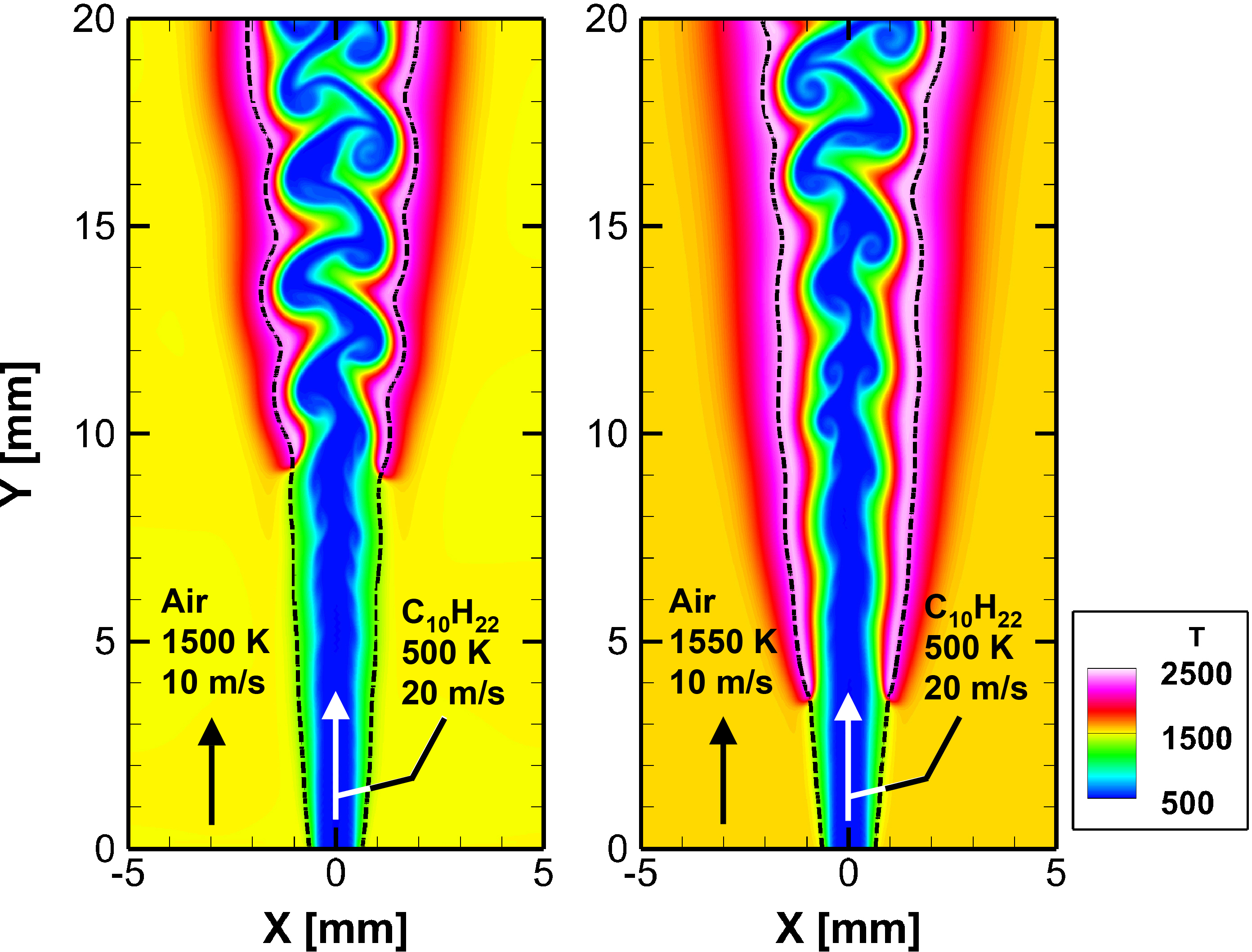Development of Robust Numerical Scheme for Kerosene Turbulent Combustion
JAXA Supercomputer System Annual Report April 2017-March 2018
Report Number: R17EA1921
Subject Category: Aeronautical Technology
- Responsible Representative: Takashi Aoyama, Aeronautical Technology Directorate, Numerical Simulation Research Unit
- Contact Information: Shingo Matsuyama smatsu@chofu.jaxa.jp
- Members: Shingo Matsuyama
Abstract
When carrying out a combustion simulation using a detailed reaction mechanism for a hydrocarbon fuel, the number of chemical species to be considered and the stiffness due to a chemical reaction become problems. In this study, by combining skeletal reaction mechanism and dynamic stiffness removal, we developed a robust numerical scheme which enables combustion simulation with large scale detailed reaction mechanism.
Reference URL
N/A
Reasons for using JSS2
When performing turbulent combustion simulation on kerosene fuel widely used in gas turbine engines, a large scale reaction model including over 100 chemical species and over 900 chemical reactions must be solved. In order to perform LES and DNS for kerosene combustion, a huge number of grid points of the order of 100 million is necessary and the number of governing equations and chemical reactions increase in proportion to the number of chemical species. Therefore, supercomputers are indispensable for carrying out such large scale combustion simulations in this research.
Achievements of the Year
In this study, a skeletal reaction model and dynamic stiffness removal was applied to perform a combustion simulation of a partially premixed flame of n-decane (Fig.1). Dynamic stiffness removal showed that combustion simulation using a large scale detailed reaction mechanism can be performed stably even with time-steps of 10-8 s that is more than 100 times larger than a characteristic time scale of chemical reaction.

Fig.1: Snapshots of instantaneous contours of temperature (in K) for a partially premixed flame of n-C10H22. The dashed line indicates the stoichiometric locations. Cited from non peer-reviewed paper [1].
Publications
■ Non peer-reviewed papers
1) Shingo Matsuyama, “Unsteady Simulation of Kerosene Partially Premixed Flame with Detailed Chemical Reaction Model”, proceedings of the fifty-fifth symposium (Japanese) on combustion, E221, 2017.
2) Shingo Matsuyama, “Development of Turbulent Combustion Analysis Code CHARIOT”, proceedings of the 49th JSASS annual meeting, 2C05, 2018.
■ Presentations
1) Shingo Matsuyama, “Unsteady Simulation of Kerosene Partially Premixed Flame with Detailed Chemical Reaction Model”, the fifty-fifth symposium (Japanese) on combustion, 2017.
2) Shingo Matsuyama, “Development of Turbulent Combustion Analysis Code CHARIOT”, the 49th JSASS annual meeting, 2018.
Usage of JSS2
Computational Information
- Process Parallelization Methods: MPI
- Thread Parallelization Methods: OpenMP
- Number of Processes: 25 – 75
- Elapsed Time per Case: 120.00 hours
Resources Used
Fraction of Usage in Total Resources*1(%): 0.02
Details
Please refer to System Configuration of JSS2 for the system configuration and major specifications of JSS2.
| System Name | Amount of Core Time(core x hours) | Fraction of Usage*2(%) |
|---|---|---|
| SORA-MA | 128,996.00 | 0.02 |
| SORA-PP | 0.00 | 0.00 |
| SORA-LM | 0.00 | 0.00 |
| SORA-TPP | 0.00 | 0.00 |
| File System Name | Storage Assigned(GiB) | Fraction of Usage*2(%) |
|---|---|---|
| /home | 598.94 | 0.41 |
| /data | 2,849.03 | 0.05 |
| /ltmp | 488.28 | 0.04 |
| Archiver Name | Storage Used(TiB) | Fraction of Usage*2(%) |
|---|---|---|
| J-SPACE | 0.00 | 0.00 |
*1: Fraction of Usage in Total Resources: Weighted average of three resource types (Computing, File System, and Archiver).
*2: Fraction of Usage:Percentage of usage relative to each resource used in one year.
JAXA Supercomputer System Annual Report April 2017-March 2018


